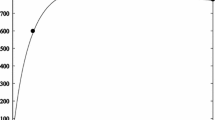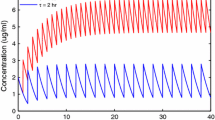Abstract
This study presents a new nonlinear two compartmental model and its application to the evaluation of valproic acid (VPA) pharmacokinetics in human volunteers after oral administration. We have used literature VPA concentrations. In the model, the integer order derivatives are replaced by derivatives of real order often called fractional order derivatives. Physically that means that the history (memory) of a biological process, realized as a transfer from one compartment to another, is taken into account with the mass balance conservation observed. Our contribution is the analysis of a specific nonlinear two compartmental model with the application in evaluation of VPA pharmacokinetics. The agreement of the values predicted by the proposed model with the values obtained through experiments is shown to be good. Thus, pharmacokinetics of VPA after oral application can be described well by a nonlinear two compartmental model with fractional derivatives of the same order proposed here. Parameters in the model are determined by the least-squares method and the particle swarm optimization (PSO) numerical procedure is used. The results show that the nonlinear fractional order two compartmental model for VPA pharmacokinetics is superior in comparison to the classical (integer order) linear two compartmental model and to the linear fractional order two compartmental model.



Similar content being viewed by others
References
Diethelm K (2010) The analysis of fractional differential equations. Springer, Berlin
Dokoumetzidis A, Macheras P (2009) Fractional kinetics in drug absorption and disposition processes. J Pharmacokinet Pharmacodyn 36:165–178
Dokoumetzidis A, Magin R, Macheras P (2010a) A commentary on fractionalization of multi-compartmental models. J Pharmacokinet Pharmacodyn 37:203–207
Dokoumetzidis A, Magin R, Macheras P (2010b) Fractional kinetics in multi-compartmental systems. J Pharmacokinet Pharmacodyn 37:507–524
Dutta S, Qiu Y, Samara E, Cao G, Granneman R (2005) Once-a-day extended-release dosage form of divalproex sodium III: development and validation of a level A in vitro–in vivo correlation (IVIVC). J Pharm Sci 94:1949–1956
Hilfer E (ed) (2000) Applications of fractional calculus in physics. World Scientific, New York
Kilbas AA, Marzan SA (2005) Nonlinear differential equations with Caputo fractional derivative in the space of continuously differentiable functions. Differ Equ 41:84–89
Kilbas AA, Srivastava HM, Trujillo JJ (2006) Theory and applications of fractional differential equations. Elsevier, Amsterdam
Kytarilos J, Dokoumetzidis A, Macheras P (2010) Power low IVIVC: an application of fractional kinetics for drug release and absorption. Eur J Pharm Sci 41:299–304
Podlubny I (1999) Fractional differential equations. Academic Press, San Diego
Popovic JK, Atanackovic MT, Pilipovic AS, Rapaic MR, Pilipovic S, Atanackovic TM (2010a) A new approach to the compartmental analysis in pharmacokinetics: fractional time evolution of diclofenac. J Pharmacokinet Pharmacodyn 37:119–134
Popovic JK, Atanackovic MT, Pilipovic AS, Rapaic MR, Pilipovic S, Atanackovic TM (2010b) Remarks on the mass balance for multi-compartmental models; a nonlinear compartmental model. J Pharmacokinet Pharmacodyn 37:217–220
Rapaić MR (2010) Matlab implementation of the Particle Swarm Optimization (PSO) algorithm. Matlab Central. http://www.mathworks.com/matlabcentral/fileexchange/22228-particle-swarm-optimization-pso-algorithm
Verotta D (2010a) Fractional compartmental models and multi-term Mittag–Leffler response functions. J Pharmacokinet Pharmacodyn 37:209–215
Verotta D (2010b) Fractional dynamics pharmacokinetics-pharmacodynamic models. J Pharmacokinet Pharmacodyn 37:257–276
Wheatcraft SW, Meerscharet MM (2008) Fractional conservation of mass. Adv Water Resour 32:1377–1381
Acknowledgments
This research is supported by Republic of Serbia, Ministry of Science grants 174024 (SP), 174005 (TA) and 32018 (ZJ) and Autonomous Province of Vojvodina, Provoncial Secretariat for science and technological development grant 114-451-2048/2011-01 (JP).
Author information
Authors and Affiliations
Corresponding author
Appendix
Appendix
In the sequel, we present a formal result regarding existence and uniqueness for the equations of the proposed model. The results are basis for the iterative procedure that can be used to construct the solution to a nonlinear fractional initial value problem (11), (12). We also propose a numerical procedure for evaluation of fractional order integrals and give an error estimate for such a procedure. The procedure is finally used to reduce a linear fractional differential equation to a system of linear algebraic equations, which can be solved in a standard way.
1.1 Reduction to integral equation
The Eq. 11 may be reduced to a Volterra integral equation. We state this as:
Theorem 1.
Let α ∈ (0, 1) and let F:[0, T] × D, D ⊆ ℜ, be a continuous bounded function, satisfying the Lipschitz condition in its second argument, i.e. let there exists a finite positive constant L such that for any t ∈ [0, T] and any x, y ∈ D
Then there exists a unique continuous solution to the initial value problem (11)
In fact, the problem is equivalent to a Volterra integral equation
The solution of (23) is the limit of the sequence of continuous functions q k (t), defined as
where
Proof
See (Kilbas and Marzan 2005).
Note.
According to assumptions (2.A) and (4.A), the fractional order models addressed in the present study satisfy the conditions of Theorem 1.
Let us explore the successive approximations method further. It is shown in Podlubny (1999) that
One can always choose t 1 ∈ (0, T] so that
and thus, according to the Banach fixed point theorem, the unique solution to the initial value problem is \( q(t) = \mathop {\lim }\nolimits_{k \to \infty } q^{k} (t). \)
The solution constructed in such a way is defined only for t ∈ [0, t 1]. However, this solution can be extended on the interval t ∈ [t 1, 2t 1]. For such a t, (23) becomes
Since the solution is know in the interval t ∈ [0, t 1], the first two terms in the above expression can be considered as a known function of time. Denote this function by y. Then
Integral equation (28) can be rewritten as
The above equation can be solved by successive approximation method, in the same way as Eq. 23, except that the domain of convergence is different. Following the same procedure repeatedly, one can expand the solution of the fractional initial value problem to the entire interval t ∈ [0, T].
1.2 Numerical procedure for evaluation of the fractional integral
We present now a numerical method to evaluate the fractional integral
with g(t) an arbitrary function having bounded first derivative. This type of integral appears in (28). Let us denote the time interval under consideration into N equally sized subinterval each of length Δ (T = NΔ). Assume that f can be approximated by a piecewise constant, left-continuous signal, i.e., assume
Left fractional integral of signal g evaluated at t = kΔ can then be approximated as
Let us introduce
The approximation can now be seen as a discrete convolution of signals g i = g(iΔ) and w α i :
The above formula represents a generalization of the forward rectangular rule used for numerical evaluation of classical, first order integrals. The formula is also known as the right rectangular or first Euler rule.
The approximation is meaningful only if g(iΔ) is defined for each i, i.e., if g is a bounded signal. The following theorem gives an upper bound on the approximation error in the case that g has bounded first derivative also.
Theorem 2.
Let N be an integer and Δ a real number. Let g:[0, NΔ] → ℜ be a continuously differentiable function such that
The following bound holds for the absolute error e α k of the approximation formula for fractional integral
where
Proof
By virtue of Taylor expansion, for any τ ∈ (iΔ, iΔ + Δ) there exists a σ τ ∈ (iΔ, iΔ + Δ). such that
Therefore,
The first sum in the above expression is, in fact, the approximation, while the second sum is the approximation error. Therefore, we have
This concludes the proof.
1.3 The simulation procedure
The Theorem above states that fractional integral of a function evaluated at time t = kΔ can be approximated by a linear combination of the function values at times t = iΔ, where 0 ≤ i ≤ k. The coefficients of this linear combination are w α i . In other words, if one denotes by g a vector with ith entry equal to g(iΔ), and by I α g a vector with ith entry equal to the approximation of \( _{0} I_{i\Updelta }^{\alpha } g \), then
where “·” denotes matrix–vector multiplication and I α is a matrix whose element at position (i, j) is \( w_{i - j}^{\alpha } \) if i > j and 0 otherwise. Denote by q 1, f(q 1) and q 2 vectors containing values of q 1, f(q 1) and q 2, respectively. The method of successive approximations is implemented as
with the initial approximation being
where 1 is a vector with all entries equal to 1. In most cases considered in the current study, the difference between the two consecutive approximations dropped below 0.001 after less than 500 iterations.
The second equation is equivalent to the following
and can, therefore, be approximated as
which can be solved explicitly as
with E being the identity matrix. The above expression can be seen as numerical implementation of the solution obtained via the Laplace transform method (see Eq. 19).
Rights and permissions
About this article
Cite this article
Popović, J.K., Dolićanin, D., Rapaić, M.R. et al. A nonlinear two compartmental fractional derivative model. Eur J Drug Metab Pharmacokinet 36, 189–196 (2011). https://doi.org/10.1007/s13318-011-0057-6
Received:
Accepted:
Published:
Issue Date:
DOI: https://doi.org/10.1007/s13318-011-0057-6




